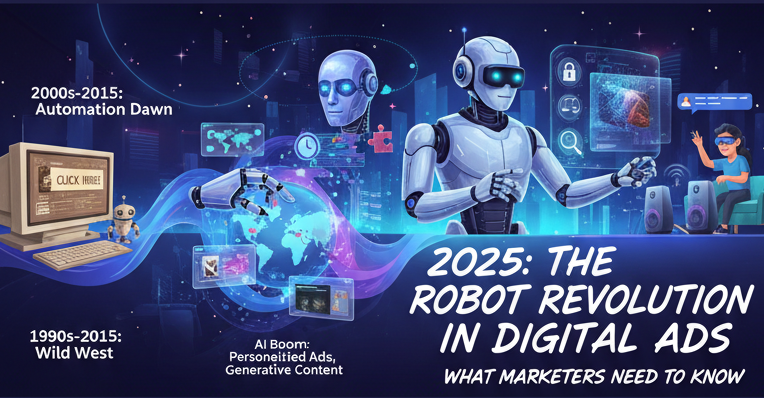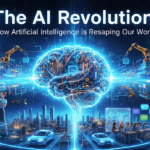Introduction: Welcome to the AI Advertising Era!
Remember those days of blanket ads, the digital equivalent of shouting into a crowded stadium? Yeah, AI doesn’t. It’s moved past the era of spray and pray, into the realm of laser-focused engagement. AI in digital advertising isn’t just a buzzword anymore—it’s optimizing, personalizing, and, dare I say, revolutionizing how brands reach you. We’re talking about smart tech automating everything from ad placement to predicting what you’ll buy next, a symphony of algorithms orchestrated to capture your attention.
A Quick Trip Down Memory Lane: How We Got Here
To truly grasp the magnitude of this shift, let’s embark on a brief archaeological dig through the annals of digital advertising history.
- The “Wild West” of Digital Ads (1990s – early 2000s): Picture a digital frontier, untamed and brimming with potential. This was the era of basic banner ads and keyword matching. Google AdWords, bless its pioneering spirit, was an early settler, but even its offerings were, shall we say, rudimentary. CPM (Cost Per Mille) was the reigning metric, a blunt instrument in a world craving precision.
- The Dawn of Automation (Mid-2000s – 2015): The landscape began to evolve. Enter programmatic advertising, making ad buying real-time and more efficient. This was the catalyst. Machine learning algorithms started flexing their predictive muscles, helping platforms like Facebook and Google get really good at knowing what tickled your fancy. As real-time bidding (RTB) became more sophisticated, the seeds of hyper-personalization were sown.
- The AI Boom (2015 – Present): Buckle up, because this is where things get interesting. Predictive analytics became the coin of the realm, and then, like a thunderclap, generative AI arrived, capable of creating ads from scratch. Now we’re talking chatbots that anticipate your needs, voice search that responds to your every whim, and AI analyzing your digital footprint to offer you “just what you wanted.” We moved beyond simple A/B testing and started using multi-armed bandit algorithms for continuous optimization.
AI in Action: What’s Happening Right Now (and What it Means for You)
So, what does this AI-powered present look like?
- Hyper-Personalization on Steroids: Forget generic ads that speak to no one and everyone simultaneously! AI is tailoring everything from the message to the visuals to you, individually. It’s like having a personal shopper curate every ad you see, anticipating your desires with uncanny accuracy. We’re not just talking about demographic targeting anymore; it’s about psychographic profiling and behavioral analysis on a granular level.
- Campaigns Running Themselves (Almost!): Imagine a world where ad campaigns manage themselves, a self-perpetuating cycle of optimization. AI is automating ad placements, bidding wars, and optimizing campaigns in real-time. It’s making ads smarter, faster, and more cost-effective, freeing up marketers to focus on strategy and creativity. We’re seeing the rise of “always-on” campaigns that adapt and evolve in response to real-time data.
- Content Creation Gets a Robotic Assistant: The creative process, once the exclusive domain of human ingenuity, is now being augmented by AI. Generative AI is churning out ad copy, social posts, and even images and videos. The “human touch” is still important, a guiding hand to ensure quality and relevance, but AI is definitely doing the heavy lifting, especially in the realm of repetitive tasks. Think of it as a collaborative partnership between humans and machines, each leveraging their unique strengths.
- Predicting Your Next Move: The crystal ball is no longer a mystical artifact; it’s an AI algorithm. AI analyzes tons of data to predict consumer behavior and market trends, so advertisers can hit you with the right ad at precisely the right moment, anticipating your needs before you even realize them yourself. This predictive capability extends beyond simple purchase intent; it encompasses brand affinity, emotional resonance, and even the likelihood of sharing an ad with your network.
- Customer Service Superstars: Remember the frustration of waiting on hold, navigating endless phone trees? Those days are fading. Chatbots and virtual assistants powered by AI are answering questions and offering personalized deals 24/7, providing instant gratification and enhancing the customer experience. These AI-powered assistants are becoming increasingly sophisticated, capable of handling complex queries and even resolving disputes with minimal human intervention.
The Elephant in the Room: Controversies and Ethical Headaches
However, this AI-powered utopia is not without its shadows. We must confront the ethical quandaries that arise from this technological revolution.
- “They Know WHAT About Me?!?” – Data Privacy: The sheer volume of data that AI consumes is staggering. AI sucks up so much personal data (browsing history, interests, even emotions!) that people are rightly asking about consent and potential privacy breaches. The line between personalization and surveillance is becoming increasingly blurred, demanding a reevaluation of data privacy regulations and ethical guidelines.
- Bias Bots: When AI Gets it Wrong: AI is only as good as the data it learns from. If the data AI learns from is biased, the ads can be too, leading to unfair or discriminatory targeting. This isn’t just a theoretical concern; it’s a real-world problem that can perpetuate existing inequalities and reinforce harmful stereotypes. Algorithmic transparency and bias mitigation strategies are essential to ensuring fairness and equity in AI-driven advertising.
- Manipulation vs. Persuasion: A Slippery Slope: The power of AI to influence behavior is undeniable. How far is too far? AI can craft ads that play on your vulnerabilities, making the line between smart marketing and outright manipulation blurry. Deepfakes in ads? That’s a whole other level, raising serious questions about authenticity and trust.
- The Black Box Problem: Who’s in Charge? Many AI systems operate as impenetrable black boxes. You don’t know why you’re seeing an ad, and if an AI makes a mistake, who’s accountable? This lack of transparency can erode trust and hinder our ability to identify and correct biases. Explainable AI (XAI) is emerging as a critical field, aiming to make AI decision-making more transparent and understandable.
- Losing the “Human Touch”? Can AI truly capture empathy and creativity, or will ads just become soulless, data-driven messages devoid of genuine human connection? The challenge lies in finding the right balance between AI-driven efficiency and human-centered design, ensuring that ads resonate with audiences on an emotional level.
- The Job Fear Factor: The rise of AI inevitably sparks anxieties about job displacement. Will AI take over all marketing jobs? (Spoiler: it’s more about new roles and strategic thinking). The focus should be on reskilling and upskilling the workforce, preparing marketers for a future where collaboration with AI is the norm.
- The “Filter Bubble” Effect: Is hyper-personalization narrowing our views by only showing us what AI thinks we want to see, creating echo chambers that reinforce our existing beliefs and limit our exposure to diverse perspectives? This raises concerns about intellectual stagnation and the erosion of critical thinking skills.
Peeking into the Future: 2025 and Beyond
Gazing into the crystal ball, what does the future of AI in advertising hold?
- AI Everywhere: Not Just a Tool, But the Fabric: Expect AI to be deeply integrated into every aspect of marketing, from email campaigns to social media. It will no longer be a separate tool but rather the very foundation upon which marketing strategies are built.
- The Cookieless Crusade: With third-party cookies dying a well-deserved death, AI will be our hero for targeting without relying on extensive personal identifiers. Synthetic data, AI-generated data that mimics real-world patterns without compromising privacy, will come to the rescue, providing a privacy-preserving alternative for targeted advertising.
- AI Agents: Your New Digital Coworkers: Intelligent AI agents will handle complex workflows, processing data and even managing tasks, freeing up marketers for bigger-picture thinking. These agents will be capable of learning and adapting, continuously optimizing their performance and providing valuable insights to their human colleagues.
- Voice and Visual Search Domination: The way we interact with technology is evolving. Get ready for more ads driven by how you speak to your devices and what images you upload to find products. Voice search optimization and visual search advertising will become increasingly important for brands looking to reach consumers in these emerging channels.
- Motion, Depth, Texture: The Visual Revolution: Static ads are becoming relics of the past. Dynamic AI-generated video and immersive AR/VR experiences are the future. These engaging formats will captivate audiences and create more memorable brand experiences.
- Ethics at the Forefront (Hopefully!): A growing awareness of the ethical implications of AI will drive a greater emphasis on responsible innovation. More focus on transparent AI, robust data governance, and mitigating bias will be crucial for building consumer trust and ensuring that AI is used for good.
- Marketers Evolve: Your role isn’t disappearing; it’s shifting to strategy, creativity, and ethical oversight. Time to level up those AI skills! The marketers of the future will be data-savvy, ethically conscious, and adept at collaborating with AI.
Conclusion: The Smart Future is Now
AI is transforming digital advertising at breakneck speed, bringing unprecedented efficiency and personalization. It’s an exciting, complex, and sometimes tricky future. Embrace the AI, understand its power, and help shape it responsibly for advertising that’s both smart and genuinely engaging. It’s our collective responsibility to ensure that AI is used to create a more engaging, ethical, and ultimately beneficial advertising ecosystem.


